Category Archives: Brush-turkey
Brush-turkey mound: I think she likes it!
Here’s a male Australian Brush-turkey showing a lady around his mound. The male is the one in front, with the bright yellow pouch dangling around his neck:

This particular Brush-turkey has been perfecting his mound for weeks. It’s good to see he’s getting some interest. Both birds are looking smart in their spring plumage.
This second picture is for scale, to show the size of the mound relative to some tree trunks and a fire gate:

The male builds and maintains the mound and invites a female to it. If she’s impressed, the female consents to mate with him and then lays her eggs in the mound. The eggs incubate and hatch without help, and the chicks emerge ready to take on the world.
Common name: Australian Brush-turkey
Scientific name: Alectura lathami
Approximate length: 60-70 cm
Date spotted: 23 September 2025 (spring)
Location: Manly Dam, New South Wales, Australia: 33°46’55.5″S 151°15’09.6″E
Did a street sweeper do this beautiful job?
A meticulously-raked verge. The busy sounds of sweeping. Is there an ace street sweeper at work?
Common name: Australian Brush-turkey
Scientific name: Alectura lathami
Approximate length of adult bird: 60-70 cm
Date spotted: 12 July 2025 (winter)
Location: Manly Dam, New South Wales, Australia: 33°46’59.5″S 151°15’18.2″E
Muscovy ducks meet a Brush-turkey
Two Muscovy ducks hiss and wag their tails to warn off an Australian Brush-turkey. The Brush-turkey had been investigating my shoes, then it decided to see what the two interesting ducks were up to. The encounter ends peacefully. No feathers flying this time!
Muscovy ducks come from the Americas, and are actually more like a cross between a goose and a duck than just a duck. They hiss like geese, although it’s a very quiet hiss. Their faces and heads look like geese, but their body shape is more like a duck’s.
I’ve seen this pair of Muscovies at Manly Dam often — they’ve made this area their home.
Common name: Australian Brush-turkey and Muscovy duck
Scientific name: Alectura lathami (Brush-turkey) and Cairina moschata (Muscovy)
Approximate length: 60-70 cm (Brush-turkey) and 76–84 cm (Muscovy)
Date spotted: 29 April 2025 (autumn)
Location: Manly Dam park, New South Wales, Australia: 33°46’44.9″S 151°14’58.4″E
If you were a baby Brush-turkey
If you were a baby Brush-turkey strolling down The Corso in Manly …

… and you could choose between a summer hat, a list of summer reads, or something that might be a worm, which would you choose?

The baby Brush-turkey is quite cute and pretty. The adults are much larger and not very pretty, though they do have a certain dinosaur dignity. Here’s an adult male from one of my other posts about Australian Brush-turkeys.

Common name: Australian Brush-turkey
Scientific name: Alectura lathami
Approximate length of adult bird: 60-70 cm
Date spotted: 11 February 2025 (summer)
Location: The Corso, Manly, New South Wales, Australia: 33°47’51.8″S 151°17’12.9″E
Brush-turkeys mating on a mound built by the male
A male Australian Brush-turkey has spent months building a wide, high mound of leaves and twigs. Now at last it’s ready, and a female comes to visit. She inspects the mound, while he ducks his head and pays court to her. She tidies things up a bit, moving the leaves around, then goes into the deep hollow he’s made in the centre of the mound. He follows her in, and the mating is done.
It takes just a few seconds. He hops on top of her, grabs the skin on her head with his beak, and covers her. Then he hops off, and she continues scratching the leaves and twigs. After a few moments, he decides to try his luck again, but she rejects him this time.
Here’s the male Brush-turkey, showing off his yellow collar, red head, and fierce eye:

When a male is wooing a female, he often makes a deep, booming call. It sounds a bit like an owl: oo-oo-oom. I managed to record one a while ago.
The female will lay her eggs, either in this male’s mound of leaves or in another one, and cover them with leaves. Then she’ll go on her way. The adults birds don’t look after the eggs. Instead, the eggs incubate in the warmth of the mound. When the chicks hatch, they have to fend for themselves. The parents don’t look after them. I sometimes see two or three chicks running around together, exploring their world. This picture of a Brush-turkey chick is from a while ago.
Common name: Australian Brush-turkey
Scientific name: Alectura lathami
Approximate length: 60-70 cm
Date spotted: 16 August 2024 (winter)
Location: Manly Dam Park, New South Wales, Australia: 33°46’59.5″S 151°15’18.2″E
Post-fire scenes from the Australian bush
The National Parks and Wildlife Service recently conducted a hazard reduction burn in one of my favourite bush-walking areas. The NPWS lights these controlled fires to burn away excess vegetation, which reduces the chance of a more severe fire raging out of control during fire season.
Many of the plants in the Australian bush are adapted to cope with fires. For example, these Hakea seedpods popped open after the fire, allowing the seeds to escape:
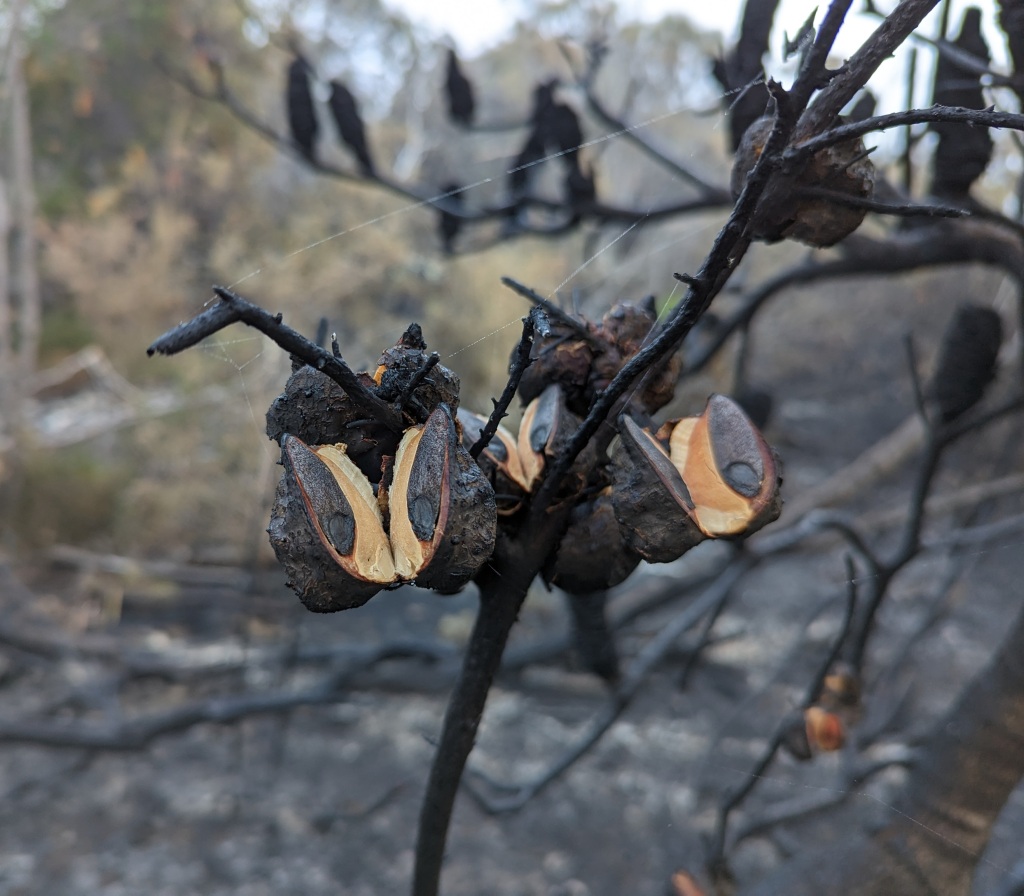
The above seed pods have both seeds still in place — the seeds are black and oval-shaped. Each seed is attached to a thin membrane, which acts as a wing: when the seed is released, it spirals gently to the ground. If there’s any wind around, the seed can travel a short distance from its parent bush.
In the next photo, only one of the seeds remains in the pod:

The next photo shows the seed head of a Banksia bush, also popped open to release the seeds. The open pods look like smiling mouths:

An Australian Brush-turkey wanders over the ashes, looking for pickings. A discarded can echoes the bird’s colouring:
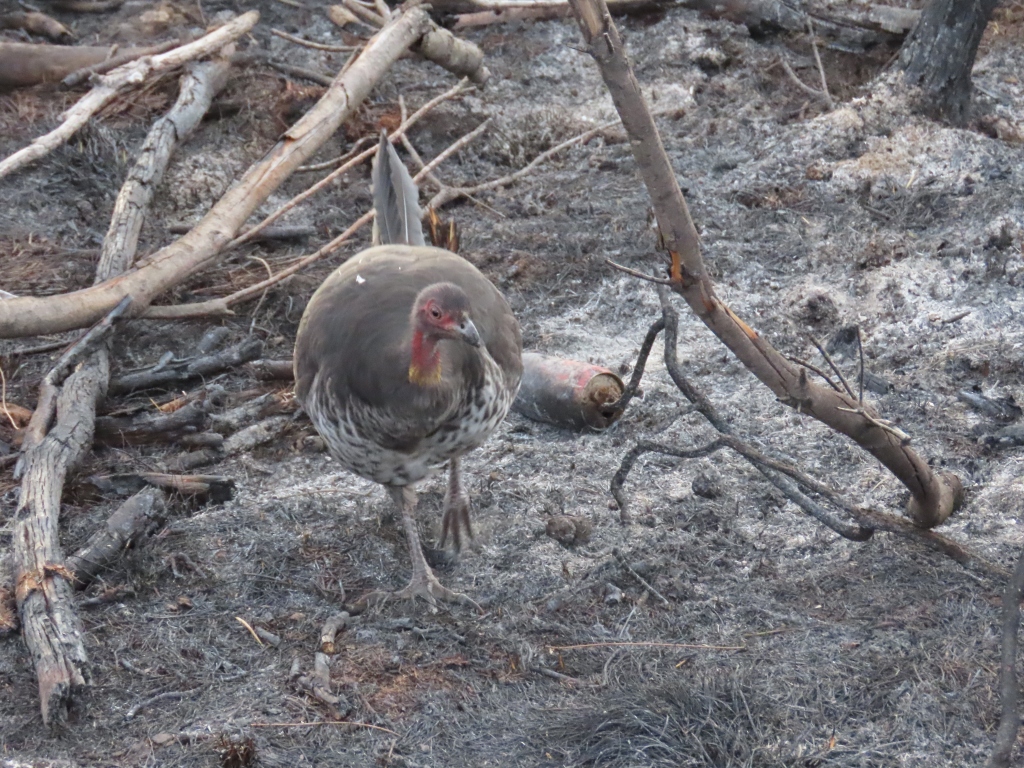
Nearby, Australian Ravens look for insects and other goodies:

A Currawong keeps a watchful eye over the proceedings:

A Rainbow Lorikeet adds a splash of colour, hoping to snag a Casuarina seed or two:
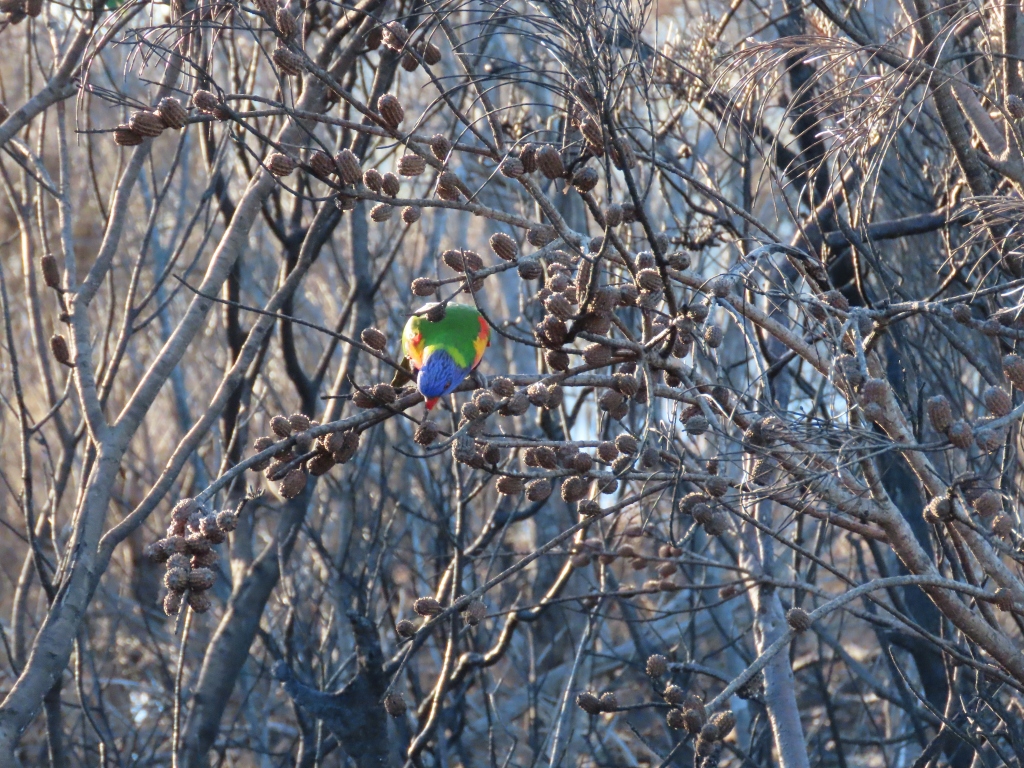
It’s much easier to grab a seed now that the fire has dried out the seedpods!
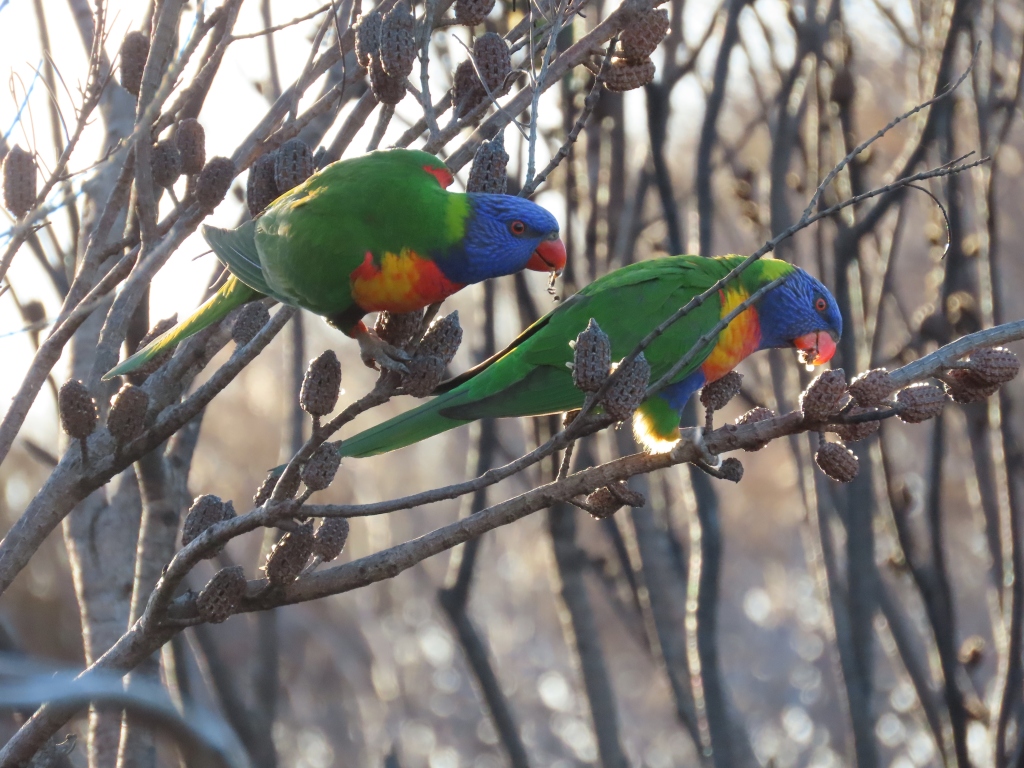
A week later, a Swamp Wallaby shared the browns and greys of the burned area too:
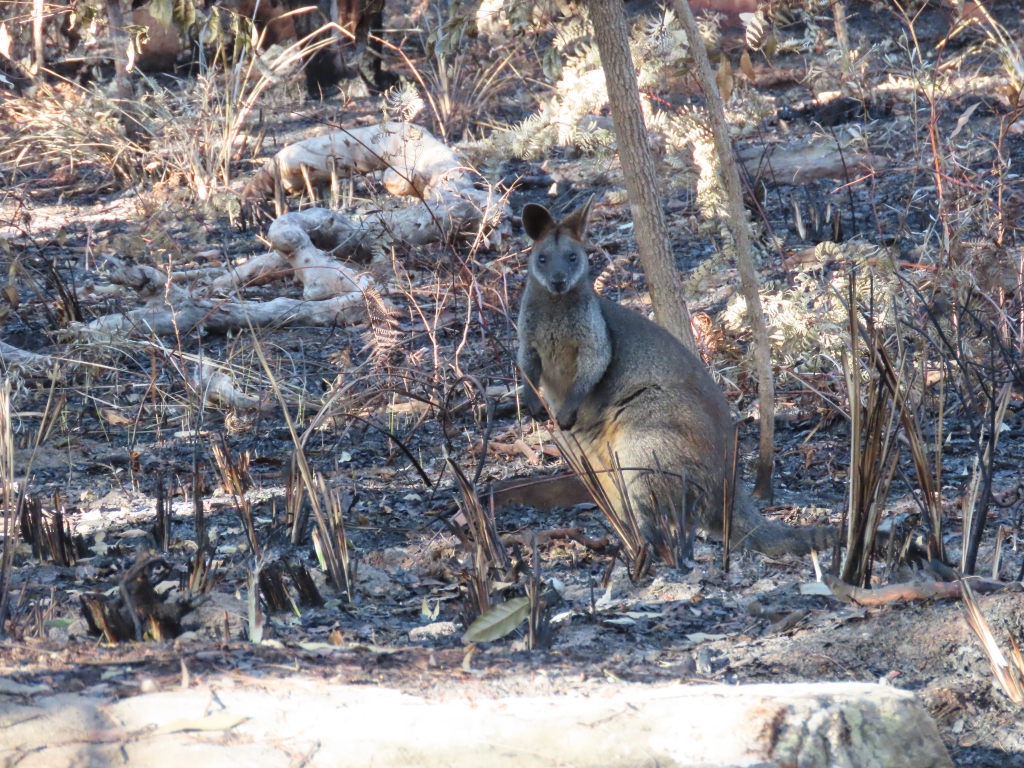
Here’s a video of the wallaby. At one stage, a plane flies overhead and a group of birds squawk loudly. The wallaby looks at me, checking whether I’m the cause of the disturbance, then goes calmly about its business:
To close, here’s a restful scene of the post-fire forest in the early morning light:

Date spotted: Early June, 2023
Location: Dobroyd Head, Sydney Harbour, NSW, Australia; between this point and this point on the map.
Australian Brush-turkeys, a wallaby, and me
Back in Sydney after a short visit to South Africa, I’m delighted to walk among the Ozzie birds again. Among them are the endearingly stupid Australian Brush-turkeys.
Here I am, following some Brush-turkeys along a path. The birds make that peculiar grunting noise that is all their own. I suppose it’s a big chicken’s version of a cluck:
Australian Brush-turkeys are funny to watch when you’re sharing the same path as them. They’re a little concerned that you’re there, but they’re also very reluctant to cede the path to you. So if you walk at normal speed, they get quite flustered and rush around trying to race you. (While taking the video, I was walking very slowly.) Eventually, one smart bird stands aside just off the path. With luck, the others decide this is a wise strategy and do the same. Alas, though, they come to this conclusion at varied times, which means there’s a lot of clucking and fluttering involved to rally troops again after the danger (you) has passed.
Here’s a still picture of the birds making their way up the path ahead of me:

A closer view of one of the birds, who has realised that she’ll have a more peaceful life if she stands on the side of the path and waits for me to pass:
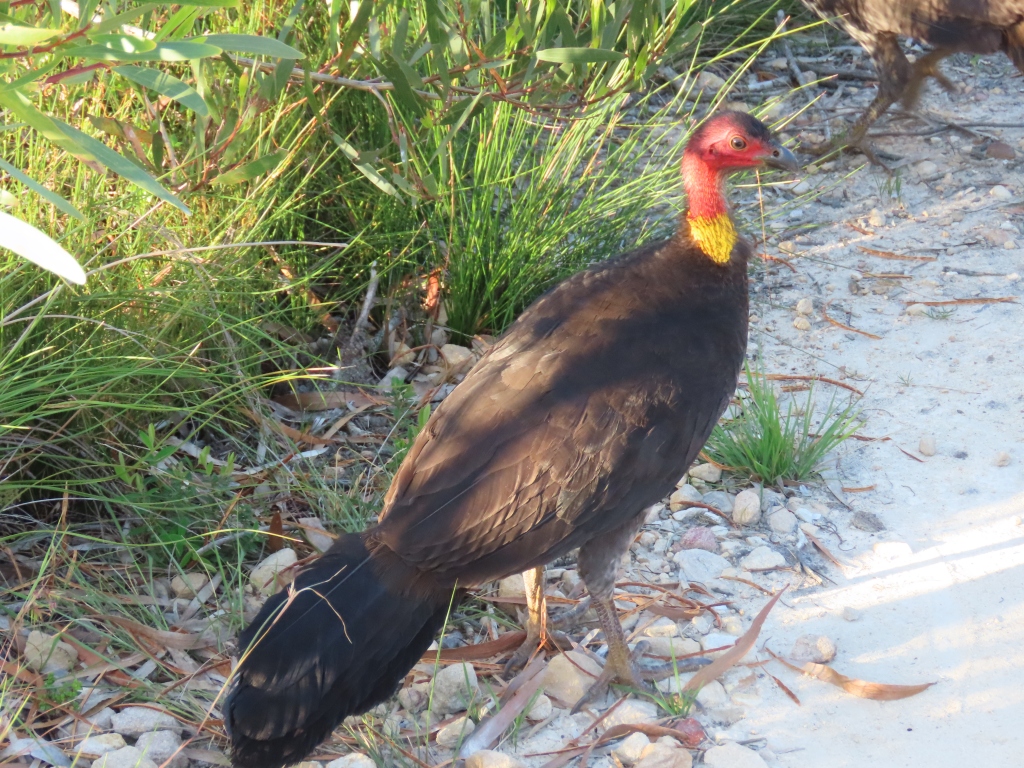
I reached the highest point of my walk and looked back down the path. The birds have found each other again and have the path to themselves:
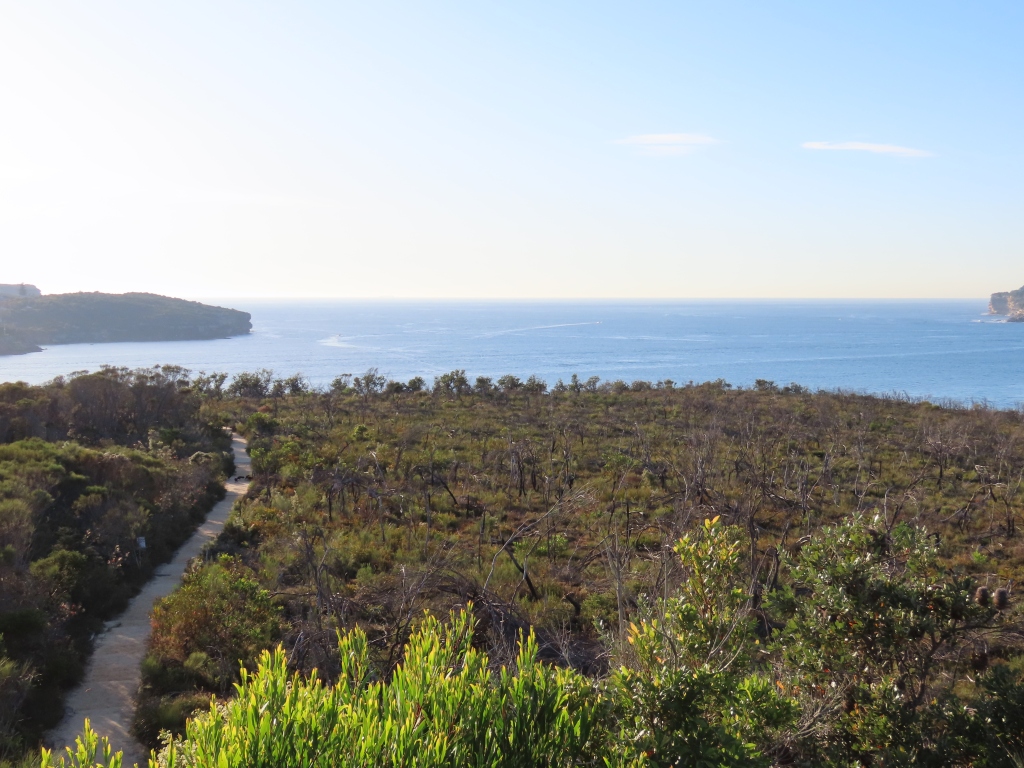
On my way back, I encountered the same group of birds, but this time with an interloper:
A Swamp Wallaby, sometimes called a Black Wallaby, was peacefully examining the path alongside the brush-turkeys. I often see these kangaroo-like marsupials out in the early morning. They’re much smaller than kangaroos, typically reaching the height of my hips when standing on their back legs. Here’s a still photo of the wallaby with the brush-turkeys:

A few weeks ago, I filmed a Swamp Wallaby in the same area of the path. It could easily be the same animal. The video shows a good view of the animal’s head and front paws as it munches away at a bush:
In the background on the video, you hear some magpies carolling, a wattle bird squawking, and a lone whip bird calling.
Australian Brush-turkey
Scientific name: Alectura lathami
Approximate length: 60-70 cm
You can see more about this bird, including some chicks and the male’s strange call, in my other posts about Australian Brush-turkeys.
Swamp Wallaby
Scientific name: Wallabia bicolor
Approximate length: 66-85 cm
Date spotted: 12 November 2022 (spring)
Location: Dobroyd Head Track, New South Wales, Australia: 33°48’35.5″S 151°16’19.7″E
Currawong snacks on brush-turkey’s scrapings
Spring is approaching, and male Australian Brush-turkeys are busily preparing their mounds in the hopes of attracting a female. This year there seem to be more brush-turkeys in my area than ever before. On the plus side, they do a great job of clearing the ground near their chosen location for a mound. On the minus side, the mound itself is a little unsightly. Unless you happen to be a brush-turkey, of course.
A canny currawong hung around close to this particular busy brush-turkey, snapping up the beetles and grubs that the brush-turkey’s scraping exposed:
The brush-turkey was scraping the leaves methodically and energetically in a single direction. His destination lay behind him. So I went round and found the large pile that he was creating. It was already over a metre high and three to four metres across.
A day later, I returned to the area and found the brush-turkey close to his mound:

Common name: Australian Brush-turkey
Scientific name: Alectura lathami
Approximate length: 60-70 cm
Date spotted: 25 August 2021 (winter)
Location: Manly Dam Park, New South Wales, Australia: 33°46’37.7″S 151°14’48.8″E
Male and female Brush-turkeys getting affectionate plus bonus baby
Over the past few weeks I’ve been watching the action at a Brush-turkey mound. The male bird is very attentive, keeping the mound in good shape and calling to attract females.
Every so often, a female arrives and starts taking the mound apart! At first I thought the male was annoyed when he pecked at the female. But watch what happens at about one minute into the video. The male is the one with the long yellow flaps hanging below its beak:
Male Australian Brush-turkeys build huge mounds of leaves and other plant matter each year. They lovingly tend the mound, spending hours every day reorganizing the leaves. Every now and then, the male utters a strange booming call (I managed to make a video of this male calling a few weeks ago) to let females know he’s ready for business.
Females come and inspect the male’s work. If they approve, the birds mate and eventually the female lays eggs in the mound. The chicks hatch of their own accord, and are immediately independent of their parents.
Several females have visited this particular mound over the weeks. I’ve been waiting for chicks to appear, but haven’t seen any yet.
In the meantime, in another area of the park today, this cute little young Brush-turkey flew past me at knee height. It was about the size of a large fist. I didn’t know they could fly at this age!
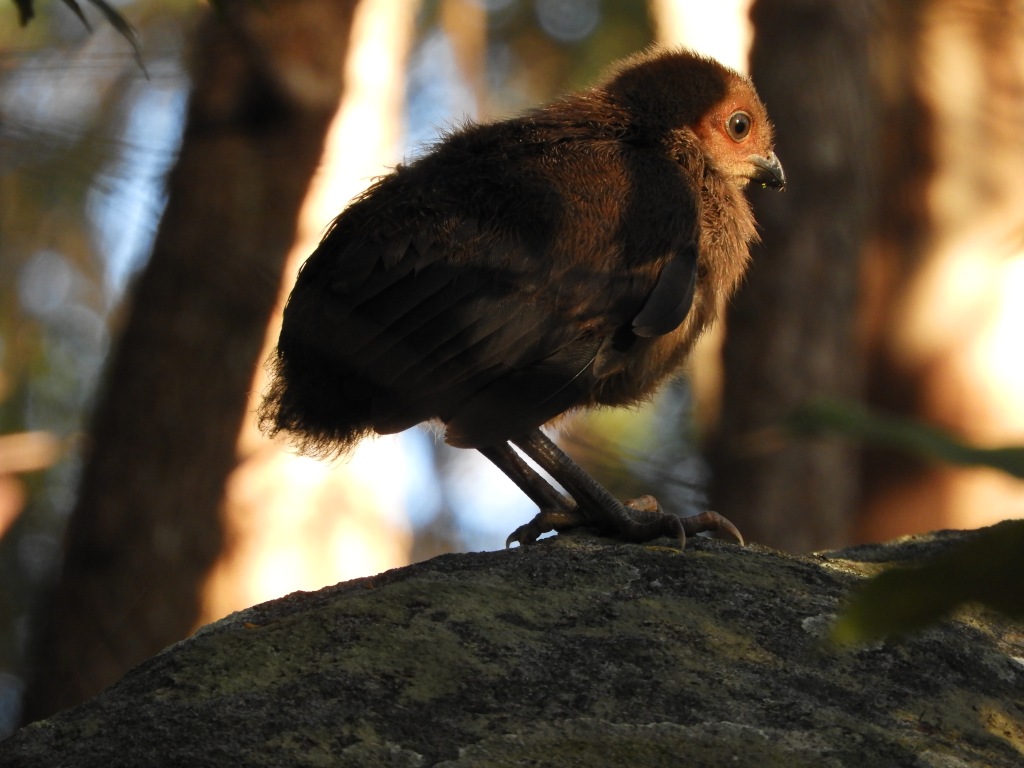
Common name: Australian Brush-turkey
Scientific name: Alectura lathami
Approximate length of adult: 60-70 cm
Date spotted: 13 December 2020 (summer)
Location of the chick: Manly Dam Park, New South Wales, Australia: 33°46’55.6″S 151°15’05.3″E
Strange call of the brush-turkey
Australian Brush-turkeys. They’re the bird everyone loves to hate. They’re not pretty to look at, and they have a habit of tearing up your garden to build their mounds. But they have a certain dignified strangeness that appeals to me.
One of the strange things about a brush-turkey is the noise it makes. The sound you’ll hear most often is a quiet grunt, like the cluck of a contented, somewhat deep-voiced domestic chicken.
But every now and then, male Australian Brush-turkeys make a weird, booming sound:
Oo-oo-oom
Listen to the sound of this male brush-turkey:
Did you hear the noise? Play the video again if you missed it. Making the noise seems to entail a lot of effort. The bird starts by ducking its head, a little like a pigeon doing a mating dance. Then it lifts its head, and the loose yellow skin hanging below its neck seems to be inflated with air. Perhaps expelling that air is what makes the noise?
Now that you’ve heard the noise, you may be able to make it out in the next video too. The bird makes the noise near the start of the video, but it’s a little masked by a chatty currawong.
Male brush-turkeys build a mound of leaves and other vegetation, then attract females to lay their eggs in the mound. The warmth from the compost heap keeps the eggs at the right temperature until they hatch. No sitting around on boring nests for this canny bird!
This particular bird seems to return to the same location to build its mound every year. The mound is uncomfortably positioned in a narrow strip between a road and a building. I guess the temperature must be just right. And maybe the presence of humans keeps predators at bay.
Here’s the proud father-to-be:
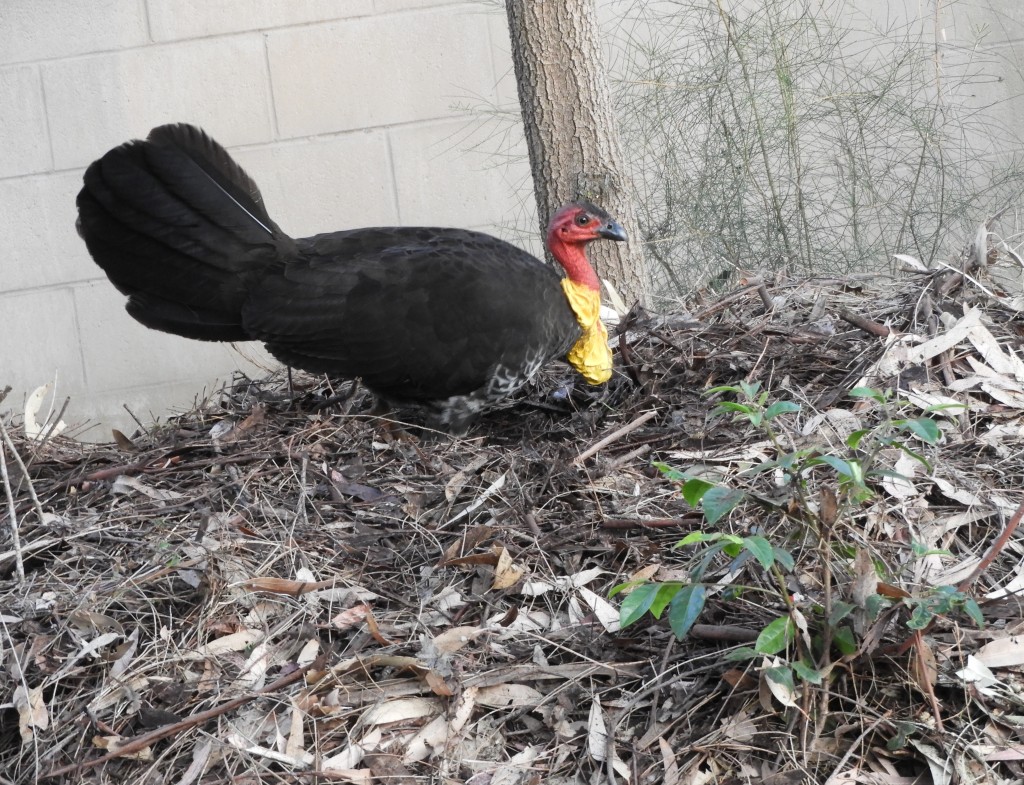
Common name: Australian Brush-turkey
Scientific name: Alectura lathami
Approximate length: 60-70 cm
Date spotted: 25 October 2020 (spring)
Location: Outside Manly Dam Park, New South Wales, Australia: 33°46’54.1″S 151°15’28.3″E






